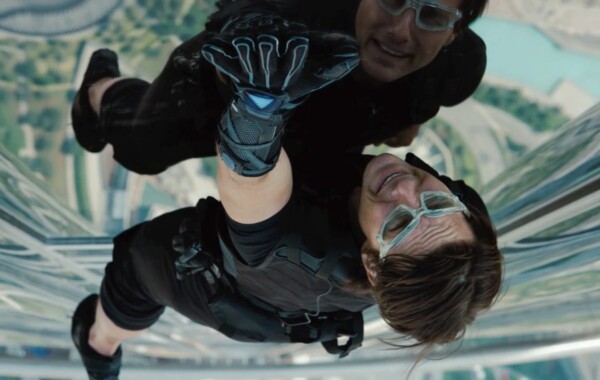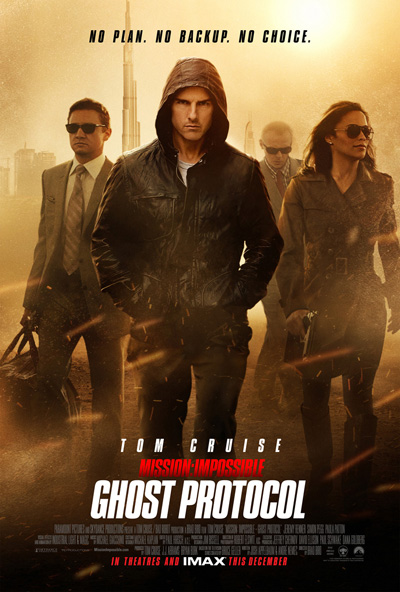Mladen and Del review ‘Mission Impossible – Ghost Protocol’

Image courtesy of Paramount.
—
“Mission Impossible – Ghost Protocol” Starring Tom Cruise, Paula Patton, Simon Pegg, Jeremy Renner. Directed by Brad Bird. 133 minutes. Rated PG-13.
Plot summary: An American black operations team is framed for blowing up part of the Kremlin. The true culprit, a rogue physicist, also uses the incident to increase tension between Russia and America as part of his plan to trigger an Earth-cleansing nuclear war between the superpowers. The black ops team seeks to clear its name and stop the physicist from fooling the governments of the superpowers into an exchange of nuclear bombs.
Mladen’s take
The recently released film “Mission: Impossible – Ghost Protocol” (MI4) should be re-titled “Mission: Implausible – Stretching Logic.”
It’s not that I’m looking for realism in a spy thriller. I’m just hoping for a plot where massive doses of lucky timing and superhuman agility and brains are less than essential to keeping a movie cohesive.
MI4 offers clever dialogue and spiffy action, even some moments of true daring, without an action movie’s critical ingredient, suspense. In the end, I didn’t much care if the nuclear warhead catapulted into space by a Russian submarine-launched ballistic missile detonated above San Francisco.
Tom Cruise reprises his role as super-agent Ethan Hunt in MI4. Cruise, now older and more handsome than cute, makes a convincing spy. His team of disavowed and pursued agents was entertaining and likable.
But, no character in the movie provoked loathing or respect, and, as a result, MI4 lacks emotional punch.
Particularly disappointing was the film’s unwillingness to develop the role played by Michael Nyqvist. He portrays out-of-control physicist Hendricks, a man with an IQ of 190 who dreams of destroying civilization.
As I understood it, Hendricks wanted to initiate a worldwide experiment in natural selection. To give evolution a shove, the physicist figured he had to clear the slate by incinerating everything on Earth with thermonuclear weapons. Cool idea, but what made the genius insane? What’s his life like during moments of respite from plotting global holocaust or running from agents possessing breathtaking spy accessories?
One more gripe. The soundtrack for MI4 was uninspired. The film didn’t offer proper homage to the irrepressible, distinctive theme from the “Mission: Impossible” TV series. The theme’s thumping beginning and portentous melody was swallowed by its conversion in MI4 to electronic technopop.
MI4 isn’t a bad movie, but it wasn’t worth the $9.75 plus tax I paid to see it. See MI4 on the big screen at a theater with high-resolution projectors, but make it a matinee.

Del’s take
Tom Cruise is crazy – not for jumping up and down on couches but for jumping out of one of the world’s tallest buildings, the Burj Khalifa in Dubai. I confess to not having watched that scene – as a lifelong acrophobic I had my hands in front of my eyes. But it’s the only lasting impression I have of “Ghost Protocol.”
Directors, producers, book editors – virtually everyone in the contemporary entertainment industry – have the impression consumers want nothing but action. On behalf of moviegoers and readers everywhere may I set the record straight? Yes, we want action. But we also want substance. We want accuracy. We want characters we care about. Finally, we want a story – however implausible – that makes sense within its context.
I’d heard “Ghost Protocol” was the best of the “Mission Impossible” canon. I came away from the movie strangely disengaged. For the most part it was entertaining and probably worth my $6.50 ticket (much to Mladen’s dismay I was given the senior citizen discount – sometimes it’s good to be a geezer!). But I wouldn’t call MI4 the best of the bunch. I didn’t care what happened because I knew no matter what, everybody would live, the day would be saved, and a sequel was probably in the works. When you find yourself nitpicking over such issues you know a movie has failed to capture your forgiveness.
Forget about thinly sketched characters, a forgettable soundtrack and a hackneyed plot. Let’s talk about technical errors. In one scene Jeremy Renner is levitated by a suit that responds to a magnetic field generated by a small RPV. I’m actually offended the scriptwriters think I’d fall for such an impossibility. A magnetic field that strong would suck up more electricity than any battery in existence could provide, nevermind the Energizer Bunnies in the RPV.
Spoiler alert: In the climactic scene a nuclear warhead attached to a rocket that is still firing hurtles toward San Francisco and clips a skyscraper. Even my vague understanding of ICBM technology tells me that once the boost phase of an ICBM is complete, multiple warheads separate from the rocket and fall toward their targets, detonating thousands of feet above. If director Bird wanted the afore-mentioned visuals he should have chosen a cruise missile.
I know – those are mere quibbles when the more important issue is: How does the movie work as a whole?
That depends on how high you set the bar. “Ghost Protocol” provides two hours of entertainment … but that’s about it. Let’s hope the next outing gives us more sympathetic characters, credible technology and a mission worthy of our time, like “Mission Impossible: Balance the Federal Budget.”
On second thought that’s waaaay too out there.
Mladen Rudman is a former journalist and technical editor. Del Stone Jr. is a former journalist and author.

James Bond (DANIEL CRAIG) and Camille (OLGA KURYLENKO) walk through the Bolivian desert. Location: Chile
Image courtesy of MGM.
—
“Quantum of Solace” Starring Daniel Craig, Olga Kurylenko, Mathieu Amalric and Judi Dench. Directed by Marc Forster. 106 minutes. Rated PG-13.
Del’s take
Don’t ask a James Bond purist what he thinks of “Quantum of Solace.” He’ll likely curl his lip, let out an exasperated huff and mutter something to the effect, “They’ve ruined 007!”
And well they might. Like many fictional characters who have made the transition from 20th century escapism to 21st century realism, Bond has been transformed. “Quantum of Solace” continues that evolution.
(Warning: Spoilers follow.)
The plot is classic 007. A super-secret organization known only as Quantum angles to depose the current Bolivian government and replace it with a strongman willing to sign over that country’s most precious resource – water. Give the screenwriters credit: They anticipate the ferocious competition predicted by climatologists to result from global warming and its diminishment of potable water supplies.
Despite orders to the contrary from the redoubtable M (Judi Dench), Bond (Daniel Craig) travels to South America to discover exactly why it is ersatz environmentalist Dominic Greene (Mathieu Amalric) has taken such an interest in an apparently barren desert. Vengeance is a subplot. Bond seeks payback for the death of Vesper Lynd while Bond’s female counterpart, a Bolivian secret service agent, Camille (Olga Kurylenko) aims to kill the appointed strongman who murdered her parents.
The action is hyperkinetic and at times almost unwatchable as exquisitely choreographed fight scenes unfold at a blistering pace, leaving Bond a dirty, bloody shambles who nevertheless prevails over the bad guy de jour.

Almost lost amid Craig’s intensity is the humor – not the campy double entendres of Roger Moore’s Bond or the sly sophistication of a Sean Connery, but actual comedy that launches unexpectedly from the darkness. Upon arriving in Bolivia, Bond is escorted by a sexy British agent to a seedy hotel where they will pose as exchange teachers. Unhappy with the accommodations, Bond takes them to the ritziest hotel in town where he explains to the desk clerk, “We are exchange teachers – and we just won the lottery.”
But much goes missing in “Quantum of Solace,” and this is where purists will hold their noses. Lost is the suave, indefatigable James Bond who emerges from a wet suit wearing a tuxedo, his hair unmussed. Gone are the insane luxuries of the super-rich, the creatively dysfunctional devices of murder (death by laser emasculation) , and the over-the-top malevolence of the ultra-evil.
Worse, we see Bond bleed, and that is not part of the Sean Connery canon of an unreachable and untouchable super man. It is as if Bond has also been tainted by the economic meltdown and would trade his beloved martinis for a can of Miller Lite.
This new Bond is more Serpico than, well, James Bond, and while that may satisfy critics one must wonder if the paying public will believe its escapist dollars have been well spent. So far box office receipts have been excellent so it’s hard to argue with numbers.
Ultimately you must ask yourself: Why do people go to movies? If it is to see a reasonable facsimile of yourself then the new, evolved James Bond may work.
But if it is to see a spectacle that rises above the gritty ordinariness of life, expect a regime change in the James Bond pantheon of superheroes.
Del Stone Jr. is a former journalist and author.